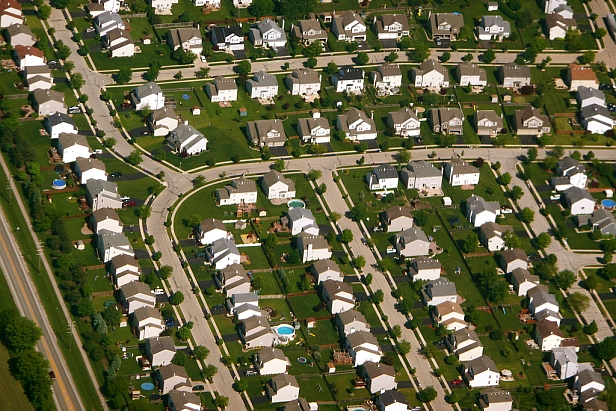 Suburban ChicagoCourtesy Scorpians and Centaurs via FlickrThe idea of racially diverse American cities ringed by mostly white suburbs is essentially flip-flopping, according to the Brookings Institution’s big new demographic report, “The State of Metropolitan America.”
Suburban ChicagoCourtesy Scorpians and Centaurs via FlickrThe idea of racially diverse American cities ringed by mostly white suburbs is essentially flip-flopping, according to the Brookings Institution’s big new demographic report, “The State of Metropolitan America.”
The report draws on 2002-2008 census data to find that young, educated whites are moving into cities in record numbers. At the same time, suburbs are becoming more diverse. For the first time, a majority of all racial and ethnic groups in large metro areas live outside the city proper.
“A new image of urban America is in the making,” Brookings demographer and report coauthor William H. Frey told the AP. “What used to be white flight to the suburbs is turning into ‘bright flight’ to cities that have become magnets for aspiring young adults who see access to knowledge-based jobs, public transportation and a new city ambiance as an attraction.”
This corresponds to Harvard Business Review‘s recent advice that companies should consider locating downtown if they want to attract young, educated workers of any race.
There’s an economic shift underway too, with suburbs becoming relatively poorer than cities. Writes the AP’s Hope Yen, “The suburbs now have the largest poor population in the country. According to the analysis, between 1999 and 2008, the suburban poor grew by 25 percent; five times the growth rate of the poor in cities. During that same time period, the median household income in the U.S. declined by $2,241.”
It all adds up to one more smackdown of the outdated picture of urban decay and idyllic suburbia. As Sarah Goodyear writes at Streetsblog, “‘Suburbs’ and ‘cities’ are no longer clearly defined categories with predictable attributes. The vast metropolitan landscape of America is far more fluid and dynamic than it has been in decades past. And old-school policy solutions are not going to be applicable to these new challenges.”
And what’s the “green” angle? It’s good that cities are rising in general popularity, as dense neighborhoods require less driving and because larger urban buildings have greater energy-efficiency potential than single-family homes. But the bright green urban vision won’t do much good if only professional-class yuppies can afford it.
The first key is improving cities without displacing low-income residents — figuring out Smart Growth without gentrification. Green urbanist types would do well to work alongside environmental-justice advocates and community organizers on this front.
The second key is figuring out how to green up the suburbs, since somebody’s still going to live there. Alex Steffen argues that it may be impossible to make outer-ring suburbs sustainable. (He makes the sub-point that it doesn’t make sense to think of suburbia as a monolithic landscape. The grid of many inner-ring suburbs — say, Oak Park, Ill., outside Chicago — is quite different than sprawling-er outer ring suburbs like Naperville, Ill.) But to the extent that suburbs can be fixed up, they need things like compact centers, passenger rail that links them to cities, and affordable housing and social services for seniors, as Brookings recommends.
So … let’s half of us fix the cities and half of us fix the suburbs. Soon as we finish rebuilding Afghanistan, of course.



